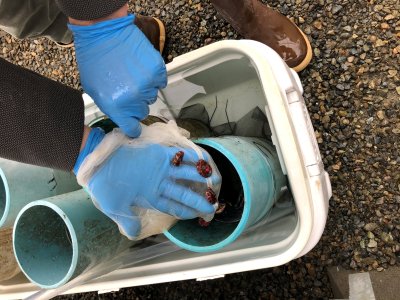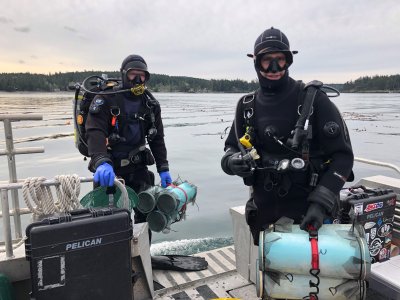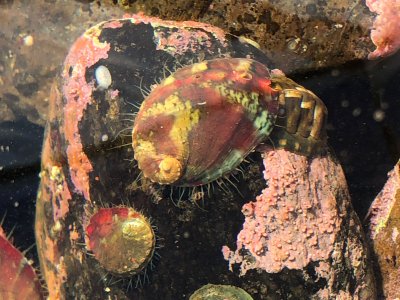WWU's Deb Donovan and her students fight to save the Salish Sea's pinto abalone
The pinto abalone once ranged in large numbers from Alaska to Baja California, but overfishing, poaching and other factors have caused them to become functionally extinct in the Salish Sea; according to figures from the Washington Dept. of Fish & Wildlife, the species has experienced a 98 percent drop in numbers since 1998 in local waters alone.
Western Washington University Professor of Biology Deborah Donovan and her students are partnering with scientists from the Puget Sound Restoration Fund and government agencies to reintroduce the pinto abalone back into the wild in sufficient numbers to allow them to claw (or in their case, crawl) back into the ecosystem’s big picture.
The pinto abalone, Haliotis kamtschatkana, is the state’s only native abalone; typically about 5 inches long, it grazes by scraping rocks with its radula, which helps make room for other important species such as kelp. Overharvesting resulted in the closure of the fishery in 1994, although numbers were already too low for successful reproduction; as a result, the pinto abalone has almost disappeared from regional waters.
Donovan has worked on abalone research since she got her doctorate in 1998, and she is passionate about the iconic gastropod.
“If you want to work in my lab, you have to be excited about abalone,” she said.
Luckily for the abalone, Donovan’s students are as excited to work on the project as she is.
“I jumped at the opportunity,” said Caitlin O’Brien, now a WWU alumna who worked on the project as a graduate student before she graduated in June. “My interest in abalone was sparked a while ago while working as a scientific diver along the California coast. The timing of our work coincided with a mass die-off of abalone there in 2009.”
Donovan said the work to restore the abalone is perfect in size and scope for her students.
If you want to work in my lab, you have to be excited about abalone.
“These kinds of projects can have a huge impact on a local species,” said Donovan. “What my students are working on can really make a big difference.’
One of the problems with restoring the abalone, explained Donovan, are that they are broadcast spawners – also known as mass spawning or synchronous spawning – which takes place when animals release their eggs and sperm into the water where fertilization occurs externally.
“With numbers so dramatically low, there are simply too few adults to aggregate and successfully reproduce,’ she said. “A minimum density needs to be achieved before abalone will be able to rebuild populations naturally.”
This is where the work of the Puget Sound Restoration Fund (PSRF), Washington Dept. of Fish & Wildlife, the National Oceanic and Atmospheric Administration, and that of Donovan and her students comes into the picture.
The PSRF operates an abalone hatchery that raises juvenile abalone, caring for them until they are about a year-and-a-half old, then releasing them into pristine rocky habitat in the San Juan Islands. More than 22,000 juveniles have been released so far.
“We’re at a crucial point of the project,” said Josh Bouma, the PSRF’s Abalone Program director. “Our research has shown we are using good strategies and putting healthy, genetically diverse juveniles on our sites. But to succeed we really need to scale it up significantly, by 10 times or more. We will need more production here in the hatchery and more research to go along with that.”
Three of Donovan’s students worked with the PSRF over the last few years on projects to make the hatchery’s efforts more successful.
Lillian Kuehl, a Biology graduate student from Blaine, studied the diets of the juvenile abalone at the hatchery. Juveniles feed almost exclusively on tiny aquatic creatures called diatoms, and Kuehl’s work involved finding the tastiest and most nutritious diatoms to feed them in an effort to reduce juvenile mortality and promote overall health.
Katie Mills-Orcutt, a Biology graduate student who graduated last summer, worked to understand the efficacy of outplanting 1.5 million new week-old larvae in the water column vs. a few hundred healthy juveniles, and whether either strategy results in more healthy adults. Releasing larvae would substantially reduce the time and effort of hatchery personnel in raising the abalone and would potentially produce juvenile abalone better suited to life in the wild.
For her project, Caitlin O’Brien realized that storing sperm would allow for greater genetic diversity (click link for video) in juveniles produced by the hatchery’s brood stock, so she developed a method to cryopreserve sperm, which required determining the best temperature to freeze the sperm, how quickly the deep freeze needed to occur, and how quickly the sperm should be thawed. She hopes a bank of frozen sperm will result in more outplanted juveniles, which in turn will increase the number of abalone performing their mission-critical roles as ecosystem engineers.
“Abalone act like Roomba vacuum cleaners on the rocky reef. Slowly, but surely, they move around an area and clear space by grazing down micro-algae that builds up on the seafloor. By constantly grazing, abalone clear habitat for species to recruit and settle that would otherwise be overgrown with micro-algae,’ she said. “This simple act of clearing space may not sound important, but it has massive repercussions on the ecosystem. Without this space it would become harder for kelp forests to establish and become the sanctuary and life source that is essential to these waters.”
This simple act of clearing space may not sound important, but it has massive repercussions on the ecosystem.
O’Brien found herself in the perfect place after she graduated in the spring – she was able to leverage her past work with the PSRF into a full-time job on the project, and now is devoting her early career to restoring abalone, much like Donovan did.
Donovan said the students’ work was a great example of collaboration between the university and off-campus entities working towards a common goal.
“Lillian, Katie, and Caitlin did all the work; they contacted Josh and found out what his needs were and then figured out how those needs intersected with their own research interests,” Donovan said.
“I’m really proud of them ... and I’m sure the abalone are too,” she said with a laugh.
For more information on Donovan’s research efforts to restore the pinto abalone, contact her at deborah.donovan@wwu.edu.


